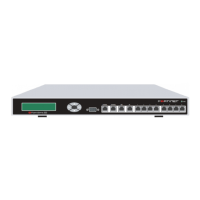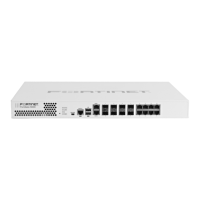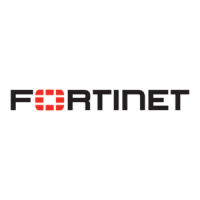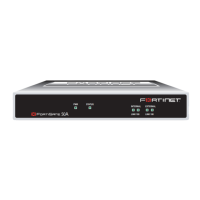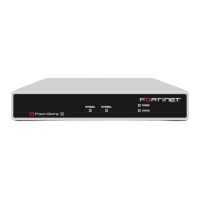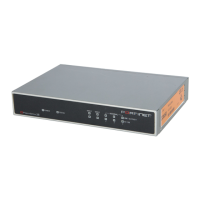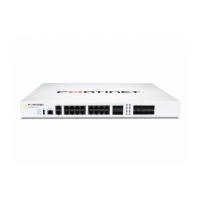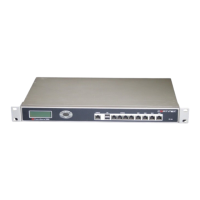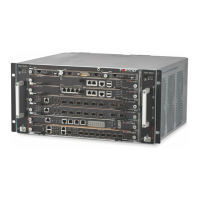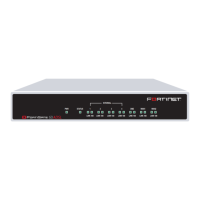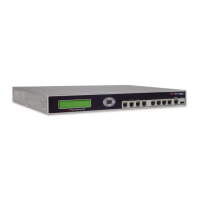Do you have a question about the Fortinet Fortigate-5000 series and is the answer not in the manual?
Provides a snapshot of the FortiGate unit's current operating status.
Explains procedures for upgrading or reverting FortiGate firmware versions.
Explains how VDOMs function as multiple independent units for security and routing.
Details the process to enable multiple VDOM operation on the FortiGate unit.
Describes settings that affect all virtual domains and VDOM-specific configurations.
Covers configuration of physical and VLAN interfaces, including ADSL and aggregate interfaces.
Explains DHCP services provided by FortiGate interfaces for automatic network configuration.
Details configuring DHCP relays and adding DHCP servers on FortiGate interfaces.
Provides information on configuring and operating FortiGate High Availability (HA) clusters.
Explains the two levels of administrator accounts: regular and system administrator.
Details how access profiles control administrator access to features and CLI commands.
Guides on backing up and restoring system configurations and managing firmware.
Explains configuration for FortiGuard Distribution Network and services.
Details how to configure static routes by specifying destination IP, netmask, and gateway.
Explains firewall policies as instructions for the FortiGate unit to manage connections.
Details how to define firewall policies to apply protection settings and manage traffic.
Defines what a firewall address can be (IP, subnet, range, FQDN).
Details how to create or edit firewall addresses, including IP ranges and FQDNs.
Explains Virtual IPs (VIPs) for allowing connections via NAT firewall policies.
Guides on adding and editing virtual IPs, including static NAT and load balancing.
Defines a protection profile as a set of settings to tailor traffic protection.
Details how to configure antivirus, web filtering, spam filtering, and IPS options.
Guides on applying protection profiles to firewall policies for traffic control.
Provides information about route-based IPSec tunnels and virtual IPSec interfaces.
Details automatic generation of unique Internet Key Exchange (IKE) keys for IPSec phase 1 and 2.
Covers basic SSL VPN settings like timeout values and encryption preferences.
Describes generating certificate requests and installing signed server certificates.
Outlines the steps for setting up user accounts, groups, and external authentication servers.
Details how to add local user accounts and configure their authentication.
Defines user groups and their role in providing authenticated access to resources.
Compares antivirus options in protection profiles and the antivirus menu.
Explains how to configure file patterns to block or prevent potential threats.
Explains the FortiGuard Intrusion Prevention System (IPS) for detecting and preventing intrusions.
Guides on enabling/disabling and configuring predefined IPS signatures.
Details how to configure web filtering settings and enable filters in protection profiles.
Explains controlling web content by blocking specific words or patterns.
Describes how to allow or block access to specific URLs by adding them to the URL filter list.
Explains configuring spam filtering options to manage unsolicited commercial email.
Details controlling spam by blocking email messages containing specific words or patterns.
Describes using IP address and email address lists to filter incoming email.
Details how to enable/disable IM/P2P options, create custom signatures, and set policies.
Explains the various network activities and traffic that a FortiGate unit can log.
Covers configuring log storage locations like memory, hard disk, FortiAnalyzer, or FortiGuard server.
Explains how to view log messages stored in memory, hard disk, or on remote servers.
Provides a snapshot of the FortiGate unit's current operating status.
Explains procedures for upgrading or reverting FortiGate firmware versions.
Explains how VDOMs function as multiple independent units for security and routing.
Details the process to enable multiple VDOM operation on the FortiGate unit.
Describes settings that affect all virtual domains and VDOM-specific configurations.
Covers configuration of physical and VLAN interfaces, including ADSL and aggregate interfaces.
Explains DHCP services provided by FortiGate interfaces for automatic network configuration.
Details configuring DHCP relays and adding DHCP servers on FortiGate interfaces.
Provides information on configuring and operating FortiGate High Availability (HA) clusters.
Explains the two levels of administrator accounts: regular and system administrator.
Details how access profiles control administrator access to features and CLI commands.
Guides on backing up and restoring system configurations and managing firmware.
Explains configuration for FortiGuard Distribution Network and services.
Details how to configure static routes by specifying destination IP, netmask, and gateway.
Explains firewall policies as instructions for the FortiGate unit to manage connections.
Details how to define firewall policies to apply protection settings and manage traffic.
Defines what a firewall address can be (IP, subnet, range, FQDN).
Details how to create or edit firewall addresses, including IP ranges and FQDNs.
Explains Virtual IPs (VIPs) for allowing connections via NAT firewall policies.
Guides on adding and editing virtual IPs, including static NAT and load balancing.
Defines a protection profile as a set of settings to tailor traffic protection.
Details how to configure antivirus, web filtering, spam filtering, and IPS options.
Guides on applying protection profiles to firewall policies for traffic control.
Provides information about route-based IPSec tunnels and virtual IPSec interfaces.
Details automatic generation of unique Internet Key Exchange (IKE) keys for IPSec phase 1 and 2.
Covers basic SSL VPN settings like timeout values and encryption preferences.
Describes generating certificate requests and installing signed server certificates.
Outlines the steps for setting up user accounts, groups, and external authentication servers.
Details how to add local user accounts and configure their authentication.
Defines user groups and their role in providing authenticated access to resources.
Compares antivirus options in protection profiles and the antivirus menu.
Explains how to configure file patterns to block or prevent potential threats.
Explains the FortiGuard Intrusion Prevention System (IPS) for detecting and preventing intrusions.
Guides on enabling/disabling and configuring predefined IPS signatures.
Details how to configure web filtering settings and enable filters in protection profiles.
Explains controlling web content by blocking specific words or patterns.
Describes how to allow or block access to specific URLs by adding them to the URL filter list.
Explains configuring spam filtering options to manage unsolicited commercial email.
Details controlling spam by blocking email messages containing specific words or patterns.
Describes using IP address and email address lists to filter incoming email.
Details how to enable/disable IM/P2P options, create custom signatures, and set policies.
Explains the various network activities and traffic that a FortiGate unit can log.
Covers configuring log storage locations like memory, hard disk, FortiAnalyzer, or FortiGuard server.
Explains how to view log messages stored in memory, hard disk, or on remote servers.
